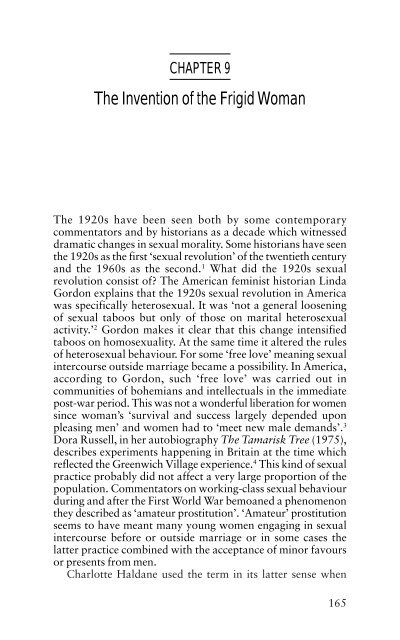The Spinster and Her Enemies - Feminish
The Spinster and Her Enemies - Feminish
The Spinster and Her Enemies - Feminish
You also want an ePaper? Increase the reach of your titles
YUMPU automatically turns print PDFs into web optimized ePapers that Google loves.
CHAPTER 9<br />
<strong>The</strong> Invention of the Frigid Woman<br />
<strong>The</strong> 1920s have been seen both by some contemporary<br />
commentators <strong>and</strong> by historians as a decade which witnessed<br />
dramatic changes in sexual morality. Some historians have seen<br />
the 1920s as the first ‘sexual revolution’ of the twentieth century<br />
<strong>and</strong> the 1960s as the second. 1 What did the 1920s sexual<br />
revolution consist of? <strong>The</strong> American feminist historian Linda<br />
Gordon explains that the 1920s sexual revolution in America<br />
was specifically heterosexual. It was ‘not a general loosening<br />
of sexual taboos but only of those on marital heterosexual<br />
activity.’ 2 Gordon makes it clear that this change intensified<br />
taboos on homosexuality. At the same time it altered the rules<br />
of heterosexual behaviour. For some ‘free love’ meaning sexual<br />
intercourse outside marriage became a possibility. In America,<br />
according to Gordon, such ‘free love’ was carried out in<br />
communities of bohemians <strong>and</strong> intellectuals in the immediate<br />
post-war period. This was not a wonderful liberation for women<br />
since woman’s ‘survival <strong>and</strong> success largely depended upon<br />
pleasing men’ <strong>and</strong> women had to ‘meet new male dem<strong>and</strong>s’. 3<br />
Dora Russell, in her autobiography <strong>The</strong> Tamarisk Tree (1975),<br />
describes experiments happening in Britain at the time which<br />
reflected the Greenwich Village experience. 4 This kind of sexual<br />
practice probably did not affect a very large proportion of the<br />
population. Commentators on working-class sexual behaviour<br />
during <strong>and</strong> after the First World War bemoaned a phenomenon<br />
they described as ‘amateur prostitution’. ‘Amateur’ prostitution<br />
seems to have meant many young women engaging in sexual<br />
intercourse before or outside marriage or in some cases the<br />
latter practice combined with the acceptance of minor favours<br />
or presents from men.<br />
Charlotte Haldane used the term in its latter sense when<br />
165

















